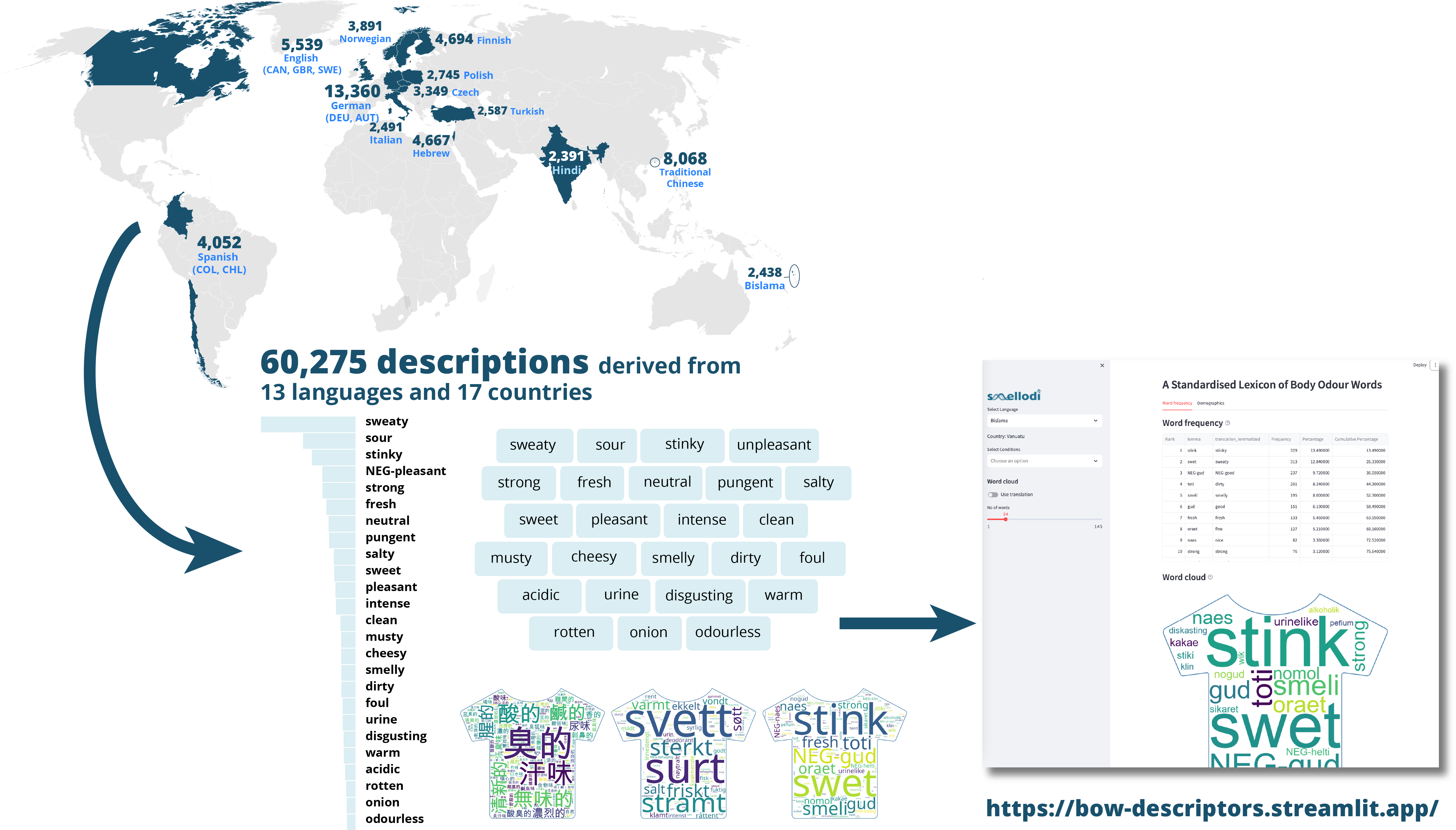From sweaty to sour - creating a lexicon of body odor words from 13 languages
Published in Neuroscience and Behavioural Sciences & Psychology

Explore the Research

A standardized lexicon of body odor words crafted from 17 countries - Scientific Data
Scientific Data - A standardized lexicon of body odor words crafted from 17 countries
Humans communicate using all their sensory modalities. While researchers have acknowledged the importance of facial expressions and voice in social interactions, the role of smell has been relatively neglected. Yet, body odors transport critical social information. Body odors can lead to emotional contagion, for example, from sweat produced by a person experiencing fear [1]. Moreover, humans prefer the body odor of their family members [2] and can identify sickness from body odors too [3].
The Challenge: A Lack of Standardized Measures
A major challenge in studying olfactory communication is the lack of a standardized framework for describing and categorizing body odor perception. Historically, body odor research has relied on broad evaluative terms such as pleasant, intense, or attractive. However, these coarse-grained descriptors fail to capture qualitative differences that may be crucial for understanding how odors influence behavior. Inspired by previous research in perfumery and cross-cultural olfactory studies [4], we sought to develop a data-driven lexicon that reflects the way laypeople describe body odors. Thus, with our recent study, we set out to create a lexicon of body odor words (BOW), which provides terms for describing body odors in multiple languages.
A Bottom-Up Approach Across 13 Languages
To create the BOW, we collected body odor descriptions from 2,607 participants across 17 countries, covering 13 languages. Participants provided free-text descriptions of odors associated with different body states (healthy, sick, stressed, after exercise) and body regions (mouth, armpit, feet, genital areas). This effort resulted in 60,275 individual odor descriptions and 7,489 unique words, which we systematically filtered down to a core set of 25 descriptors that appeared consistently across languages (see image below). Analyzing the resulting lists, we see striking cross-cultural similarities in how people describe body odors, e.g., sweaty and sour emerging as prominent descriptors across languages. On the other hand, each language demonstrated its own specific way of describing body odors, such as a specific term for “smelly toes” in Norwegian. In addition to cross-cultural comparison, our dataset demonstrates differential use of descriptors for different body states. While healthy body odors were often associated with fresh or neutral, sick body odors were dominated by terms like sour and stinky. Furthermore, different body regions exhibited distinct odor profiles: feet were often described as cheesy, while mouth odors were more frequently labeled as either fresh or stinky.

How to Make Use of BOW?
With BOW, we provide a dataset encompassing body odor descriptions from more than 2,000 laypeople across 17 countries. Thus, BOW enables cross-cultural comparison of body odor descriptions. Moreover, BOW can be used by researchers in the field of body odor for choosing qualitative labels to describe body odors. For that purpose, we provide BOW in 13 language-specific lists, as well as a list of cross-linguistically valid terms in English. The dataset is available via this link. We also provide an interactive web application to explore and download datasets of descriptors filtered by country, language and condition via this link.
Interested to Join BOW?
Is your language missing in BOW? Researchers interested in conducting this online study in additional languages are warmly encouraged to get in touch with us via e-mail to the corresponding author.
References
- De Groot, J. H., & Smeets, M. A. (2017). Human fear chemosignaling: evidence from a meta-analysis. Chemical senses, 42(8), 663-673.
- Schäfer, L., Sorokowska, A., Sauter, J., Schmidt, A. H., & Croy, I. (2020). Body odours as a chemosignal in the mother–child relationship: new insights based on an human leucocyte antigen-genotyped family cohort. Philosophical Transactions of the Royal Society B, 375(1800), 20190266.3. Olsson, M. J., Lundström, J. N., Kimball, B. A., Gordon, A. R., Karshikoff, B., Hosseini, N., ... & Lekander, M. (2014). The scent of disease: human body odor contains an early chemosensory cue of sickness. Psychological science, 25(3), 817-823.
- Olsson, M. J., Lundström, J. N., Kimball, B. A., Gordon, A. R., Karshikoff, B., Hosseini, N., ... & Lekander, M. (2014). The scent of disease: human body odor contains an early chemosensory cue of sickness. Psychological science, 25(3), 817-823.
- Majid, A. (2021). Human olfaction at the intersection of language, culture, and biology. Trends in Cognitive Sciences, 25(2), 111-123.
Follow the Topic
-
Scientific Data

A peer-reviewed, open-access journal for descriptions of datasets, and research that advances the sharing and reuse of scientific data.
Related Collections
With Collections, you can get published faster and increase your visibility.
Data for crop management
Publishing Model: Open Access
Deadline: Jan 17, 2026
Computed Tomography (CT) Datasets
Publishing Model: Open Access
Deadline: Feb 21, 2026

Please sign in or register for FREE
If you are a registered user on Research Communities by Springer Nature, please sign in